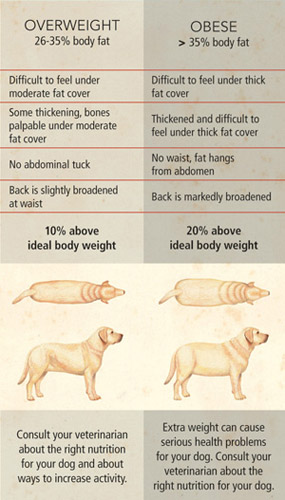By: Travis County Kennel Club • Download article as PDF
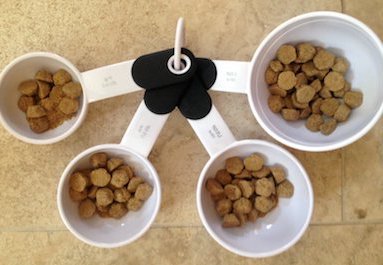
What’s Your REAL Cup Size?
Canine obesity is the most common nutritional problem seen in vet clinics in North America.
According to the World Animal Foundation, “On average, 56% of adult dogs are obese. Obesity is a problem in America and affects adult dogs who are feasting on premium food and treats. It’s an epidemic and unhealthy. Insured pets may not qualify for pet insurance if it’s a pre-existing condition.” (August 2024)
Any breed can become overweight but it is most commonly seen in Labrador Retrievers, Golden Retrievers, Beagles and Pugs.
Being obese for a long period of time predisposes your dog to joint disease, respiratory disease, pancreatitis, diabetes, skin disease, cancers and heart problems. In a study conducted by Purina, dogs that were considered moderately overweight (not obese) for their lifetime had a 15 percent reduction in life span.
In other words, overweight and obese dogs die younger.
How much should my dog eat?
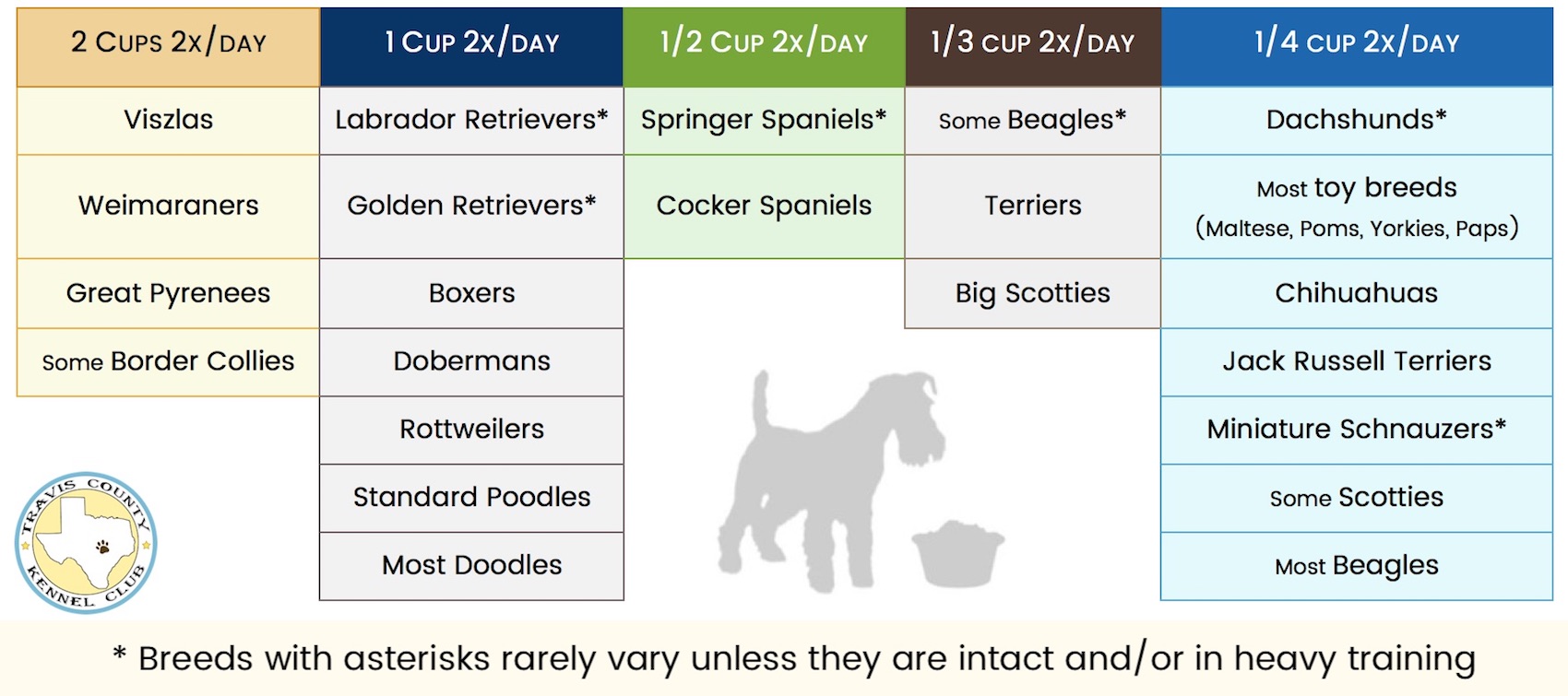
More Info on Average Food Amounts by Breed
Surprisingly, not as much as you think. For instance, the average Golden or Labrador Retriever eats two cups a day. That’s one actual eight-ounce cup (not a Rudy’s 32-ouncer or a Big Gulp cup) twice a day.
Yes, there are exceptions but they are very few. In general, intact dogs can eat more food than spayed or neutered dogs. Research has shown that a dog’s metabolism slows down within 24 hours of being spayed or neutered (those hormones again).
And obviously exercise makes a difference too. Just like us, dogs that get lots of exercise can eat more.
But it’s my hormones…
Sometimes it actually is. BEFORE STARTING ANY DIET PLEASE GET YOUR DOG’S THYROID CHECKED BY YOUR VETERINARIAN.
It’s a simple blood test and low thyroid (hypothyroidism) is frequently the reason dogs gain weight even though their food intake remains the same. Some studies have shown there is actually a higher incidence of hypothyroidism in dogs that are spayed or neutered at a young age.
What’s the Problem? The bag says…
But the bag says..
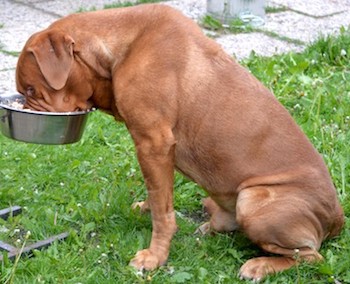
The goal of the dog food manufacturer is to sell dog food. Obviously they are going to err on the side of too much food instead of not enough food. Thus, “the back of the bag” cannot really be trusted. In many cases, it recommends a significant amount more than your dog should actually be eating.
First off, forget what the back of the bag says. It doesn’t bother the manufacturer if that “extra half cup” they recommend actually adds unwanted pounds to your dog year after year. Also, food recommendations on the bag of dog food don’t take into consideration the breed, exercise levels or whether the dog is intact or spayed or neutered. “But he’s 87 pounds!” you exclaim. Yes, and you made him that way.
Many people find their 87-pound overweight dog on the back of the bag and think they need to feed for an 87-pound dog.
Instead you should feed for a 70-pound dog; the weight he should be and not the dog’s current 87-pound (over-)weight.
A good rule of thumb is feed the dog, not the bowl.
What if it’s diet food?
Just because it’s diet food doesn’t mean you should eat the whole package. Diet foods are usually lower in calories but they are also lower in other nutrients too. It is interesting that a dog that normally should eat 2 cups of food a day frequently eats 3 cups of diet food.
Just because it’s a Lean Cuisine it doesn’t mean you should eat two at a time. Diet foods are misleading and difficult to administer the correct amounts.
We find it is best to feed your dog a good quality dog food but smaller portions. Dogs can lose weight while still eating the normal amount for their breed. Of course this means no in between meal snacks and carefully measured portions.
Those TREATS add up
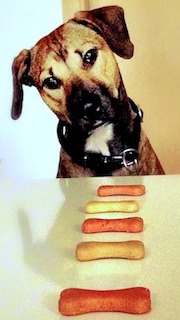
Some dogs are actually eating the proper amounts they should be eating in their bowl. As with us, it’s the snacks that put on those extra pounds. We’ve actually taken a large dog cookie, broken it up and measured the amount. In many cases it’s half a cup of food (or 120 calories). That is more than 10% of the daily requirement for a 75-pound dog. A teaspoon of oil contains 40 calories; that’s 25% of the daily requirement for a 5-pound dog.
All those studies that show how just a couple of soft drinks a week can add up to an extra ten pounds a year are true for our canine friends too. An extra 4 ounces in the form of a cookie can really add up day after day. There are low calorie treats available or you can just put a handful of their kibble (subtracted from their regular meal, of course) in your pocket and dole that out as a special treat. They honestly won’t know the difference and will probably think they are getting special “people food.”
And to make your dog feel full there is always the tried and true method of adding canned green beans or canned pumpkin to your dog’s meal. Rice cakes, popcorn and fresh carrots make good in between meal snacks.
How do I know if my dog is getting too much food?
Like us, your dog should have a waist. Looking down from the top your dog should not look like a tube. It should look like an hourglass.
You should be able to feel your dog’s ribs easily (you shouldn’t have to dig for them). You should be able to feel your dog’s spine and hip bones but not see them.
You should also be able to feel the tips of the shoulder blades and the last rib in your dog. Other clues that your dog may be packing a few extra pounds are wrinkles over the withers or shoulders. Fat pads on the back or at the base of the tail indicate extreme obesity.
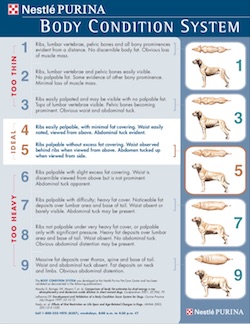
download PDF
Most dogs consume food very quickly and in one sitting. If your dog picks at his/her food or leaves it all day long and doesn’t finish it until dinnertime, you could be over-feeding your dog.
Another sign is a high volume of stool. Some dogs don’t even gain weight with extra food; they just eliminate the excess. Excess stool can also be a sign of poor quality, not easily digested food.
Just like us, even half a cup of food too much can translate into an extra pound or two a month until pretty soon your dog is very overweight.
Some lucky dogs don’t actually gain the unwanted pounds but instead produce a lot of stool. Eliminating twice a day is normal. Producing several stools a day is not normal and is frequently a sign of an overfed dog.
Check out this PDF from Purina dog food. It includes drawings and descriptions of canine body conditions, from emaciated to obese.
For further reading — Purina® Body Condition System is a nine-point system that evaluates a dog’s body condition. Learn More
But my dog is HUNGRY

Of course it is.
Almost all dogs act hungry all the time. They are opportunists. It is in their best interest to eat every chance they get and to stock up when they can.
In fact, a dog that doesn’t eat every time you feed it is usually either sick or stressed. I know it feels like you are depriving your child but honestly, who always gets to eat everything that he/she wants all the time…without some serious consequences? Wouldn’t we all love to just eat ice cream and chocolate all day long?
Dogs are not any different. I know we want to indulge them but we risk shortening their lives by doing so.
You can have great success helping your pet shed unwanted pounds by continuing to feed a high quality dog food (not “diet” food) in the amounts appropriate for the size and breed of dog, combined with running free in a fenced in area and play yard exercise. No treadmill or beach running until your pet is closer to a normal weight because steady jogging would put too much strain on an overweight dog’s joints.
Average Amounts
Average Amounts
The following are the average amounts of food for various breeds.

Once again these are based on an 8-ounce measuring cup (not a 32 oz Big Gulp cup).
We realize some of these amounts seem very small. And yes, there are some exceptions to the above but they are very rare
We have surveyed many breeders and owners for a consensus of how much they feed their particular breed and the above amounts are the common denominators for those breeds.
What is Canine Obesity?
According to Elizabeth Pask and Laura Scott, authors of “Overeaters Anonymous, the Biggest Canine Loser,” (Read Full Article) obesity occurs when a dog weighs more than 10 to 15 percent above his ideal or fit body weight. For instance, a Chihuahua that should weigh 5 pounds will be obese if he carries an extra half-pound, while a Labrador Retriever who should weigh 66 pounds might not be obese until he weighs more than 73 pounds.
The following table is from their article (printed in Modern Canine).

What is the Big Deal ?!
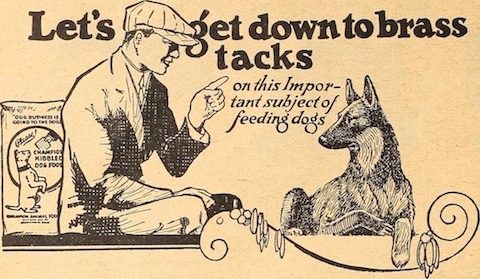
I know it sometimes feels like everyone is harping about your dog’s weight, but it’s only because we care.
Dogs get all the same obesity related illnesses we get and it is very frustrating to see pets gain weight year after year even though they can’t open the refrigerator or pour the food in their bowl.
If you have trouble resisting those puppy dog eyes and tend to over-indulge your darling, take your dog for a walk around the block; they’ll like that even better.
We want to see your companion live a long and healthy life!
For more information on your dog’s diet, visit
originally posted on TCKC: 02/03/2018
